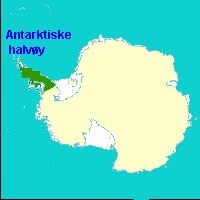 Courtesy: http://www.coolantarctica.com
Courtesy: http://www.coolantarctica.com
The Chinstrap Penguin, Pygoscelis antarcticus, is a species of
penguin which is found in the South Sandwich Islands,
Antarctica, the South Orkneys, South Shetland, South Georgia, Bouvet
Island and Balleny.
Their name derives from the narrow black band under their heads
which makes it appear as if they are wearing black helmets,
making them one of the most easily identified types of penguin.
Other names for them are "Ringed Penguins", "Bearded
Penguins",
and "Stonecracker Penguins" due to their harsh call.
Chinstrap Penguins grow to 68 cm (27 in) in length, and a weight
of 6 kg (13.2 lbs) [2], however weight can drop as low
as 3 kg (6.6 lbs) based on where the penguin is in the breeding
cycle. Males are both larger and heavier than females.
Their diet consists of krill, shrimp and fish.

Courtesy: http://www.coolantarctica.com
They live both on barren islands and large icebergs of the sub-Antarctic
Region and the Antarctic Peninsula, however,
they require solid, snow-free ground to nest on. The chinstrap penguin
eats mostly krill and some fish, while their primary
predator is leopard seals. There are about 12 to 13 million chinstrap
penguins, and have an average life span of 15 to 20 years.

Courtesy: http://www.coolantarctica.com
On land they build circular nests from stones, and lay two eggs,
which are incubated by both the male and the female
for shifts of 6 days. They can also breed on icebergs, though they
prefer non-icy conditions. The chicks hatch after about 37 days,
and have fluffy gray backs and white fronts. The chicks stay in
the nest for 20–30 days before they go to join a creche.
At around 50–60 days old, they moult, gaining their adult feathers
and go to sea.

Courtesy: http://www.coolantarctica.com
Chinstrap penguins swim up to 50 miles off-shore each day to feed
on fish, squid and krill.

Photo: Gilad Rom
|
|
Adelie penguin is the southernmost species, common on all
coasts of the Antarctic continent. For the two related species,
chinstrap, Pygoscelis antarctica and gentoo
Pygoscelis papua, penguins, the Antarctic Peninsula
is the southernmost breeding area. The bulk of chinstraps
population (5 millions out of 6.5 worldwide) breeds on South
Sandwich Islands. Gentoos occur on all Scotia Sea island groups,
with around 100,000 on South Georgia, 70,000 on the Falklands,
but only a hundred on Tierra del Fuego (on Isla de los Estados).
|

Chinstrappenguins,
Hope Bay. |
All three species have similar habits. Gentoos tend to have smaller
colonies, with large, widely spaced nests.
Northern gentoos are a different subspecies: slightly larger and less
migratory.
They breed earlier and eat more fish.
Chinstraps feed almost exclusively on krill.

Chinstrap
and Adelie penguins, All three Pygoscelis penguins
sometimes form joint colonies, but don't mix completely,
Hope Bay.
|

Gentoo
penguin creche, with king penguins, southern elephant and
Antarctic fur seals.
Gold Harbour, South Georgia |















